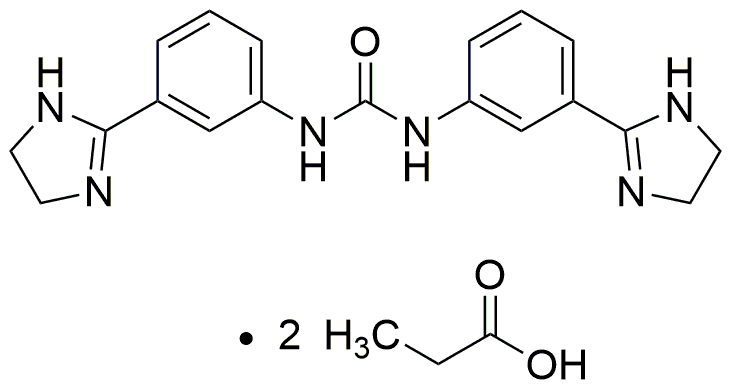Imidocarb dipropionate is widely utilized in research focused on:
- Veterinary Medicine: It is primarily used as an antiparasitic agent in livestock and pets, effectively treating infections caused by protozoa such as Babesia and Theileria.
- Pharmaceutical Development: Researchers explore its potential in developing new treatments for various parasitic diseases, leveraging its unique mechanism of action to enhance efficacy.
- Agricultural Applications: It can be used in formulating veterinary drugs that help in controlling parasitic infections in agricultural animals, thus improving livestock health and productivity.
- Research Studies: It serves as a valuable tool in laboratory studies aimed at understanding the biology of parasitic infections and testing new therapeutic strategies.
- Comparative Efficacy: Imidocarb dipropionate is often favored over similar compounds due to its prolonged action and lower toxicity, making it a safer choice for both animals and humans in research settings.
General Information
Properties
Safety and Regulations
Applications
Imidocarb dipropionate is widely utilized in research focused on:
- Veterinary Medicine: It is primarily used as an antiparasitic agent in livestock and pets, effectively treating infections caused by protozoa such as Babesia and Theileria.
- Pharmaceutical Development: Researchers explore its potential in developing new treatments for various parasitic diseases, leveraging its unique mechanism of action to enhance efficacy.
- Agricultural Applications: It can be used in formulating veterinary drugs that help in controlling parasitic infections in agricultural animals, thus improving livestock health and productivity.
- Research Studies: It serves as a valuable tool in laboratory studies aimed at understanding the biology of parasitic infections and testing new therapeutic strategies.
- Comparative Efficacy: Imidocarb dipropionate is often favored over similar compounds due to its prolonged action and lower toxicity, making it a safer choice for both animals and humans in research settings.
Documents
Safety Data Sheets (SDS)
The SDS provides comprehensive safety information on handling, storage, and disposal of the product.
Product Specification (PS)
The PS provides a comprehensive breakdown of the product’s properties, including chemical composition, physical state, purity, and storage requirements. It also details acceptable quality ranges and the product's intended applications.
Certificates of Analysis (COA)
Search for Certificates of Analysis (COA) by entering the products Lot Number. Lot and Batch Numbers can be found on a product’s label following the words ‘Lot’ or ‘Batch’.
*Catalog Number
*Lot Number
Certificates Of Origin (COO)
This COO confirms the country where the product was manufactured, and also details the materials and components used in it and whether it is derived from natural, synthetic, or other specific sources. This certificate may be required for customs, trade, and regulatory compliance.
*Catalog Number
*Lot Number
Safety Data Sheets (SDS)
The SDS provides comprehensive safety information on handling, storage, and disposal of the product.
DownloadProduct Specification (PS)
The PS provides a comprehensive breakdown of the product’s properties, including chemical composition, physical state, purity, and storage requirements. It also details acceptable quality ranges and the product's intended applications.
DownloadCertificates of Analysis (COA)
Search for Certificates of Analysis (COA) by entering the products Lot Number. Lot and Batch Numbers can be found on a product’s label following the words ‘Lot’ or ‘Batch’.
*Catalog Number
*Lot Number
Certificates Of Origin (COO)
This COO confirms the country where the product was manufactured, and also details the materials and components used in it and whether it is derived from natural, synthetic, or other specific sources. This certificate may be required for customs, trade, and regulatory compliance.


